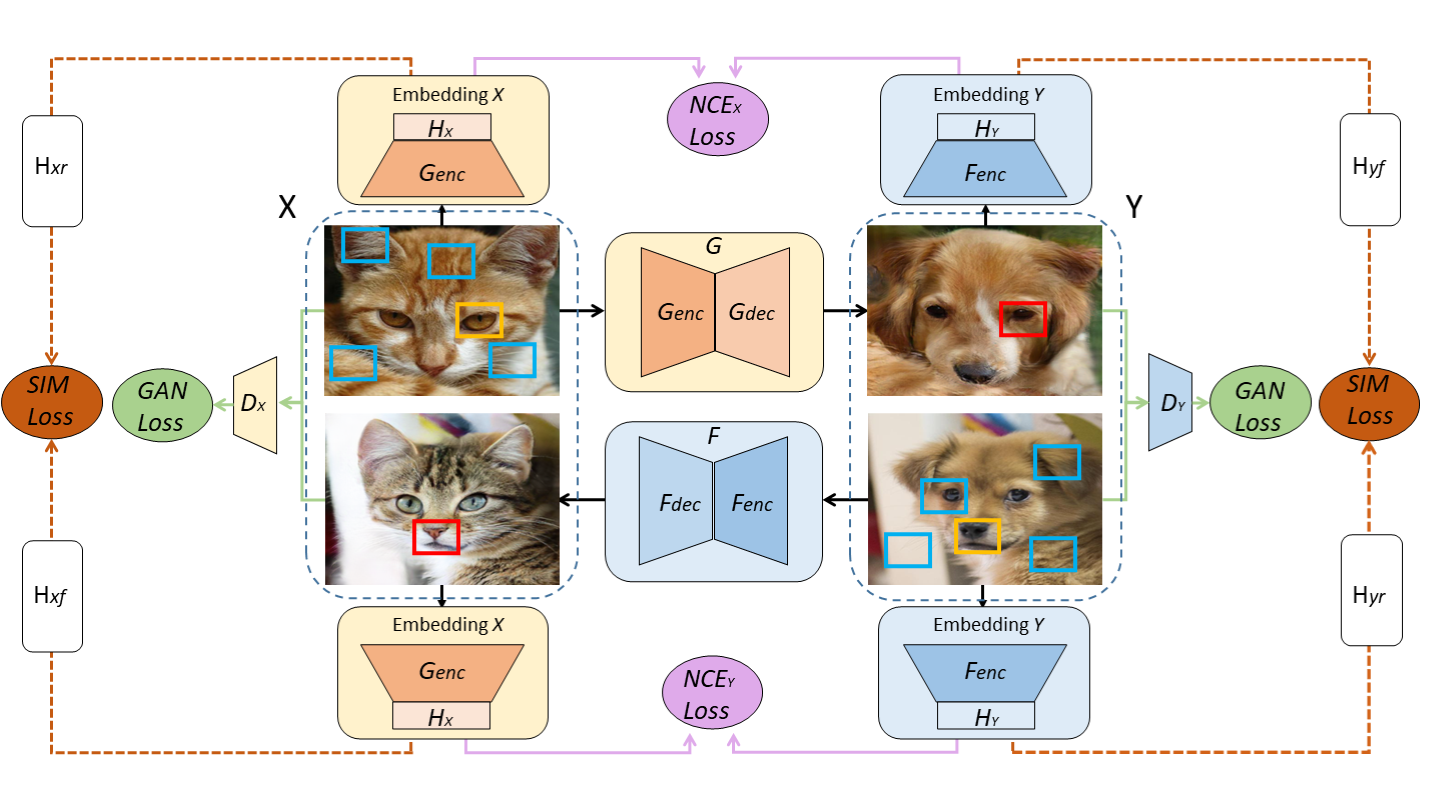We provide our PyTorch implementation of DCLGAN, which is a simple yet powerful model for unsupervised Image-to-image translation. Compared to CycleGAN, DCLGAN performs geometry changes with more realistic results. Compared to CUT, DCLGAN is usually more robust and achieves better performance. A viriant, SimDCL (Similarity DCLGAN) also avoids mode collapse using a new similarity loss.
DCLGAN is a general model performing all kinds of Image-to-Image translation tasks. It achieves SOTA performances in most tasks that we have tested.
Dual Contrastive Learning for Unsupervised Image-to-Image Translation
Junlin Han, Mehrdad Shoeiby, Lars Petersson, Mohammad Ali Armin
DATA61-CSIRO and Australian National University
In NTIRE, CVPRW 2021.
Our pipeline is quite straightforward. The main idea is a dual setting with two encoders to capture the variability in two distinctive domains.

Qualitative results:
Quantitative results:
More visual results:
Python 3.6 or above.
For packages, see requirements.txt.
- Clone this repo:
git clone https://github.com/JunlinHan/DCLGAN.git-
Install PyTorch 1.6 or above and other dependencies (e.g., torchvision, visdom, dominate, gputil).
For pip users, please type the command
pip install -r requirements.txt.For Conda users, you can create a new Conda environment using
conda env create -f environment.yml.
- Download the
grumpifycatdataset
bash ./datasets/download_cut_dataset.sh grumpifycatThe dataset is downloaded and unzipped at ./datasets/grumpifycat/.
- To view training results and loss plots, run
python -m visdom.serverand click the URL http://localhost:8097.
Train the DCL model:
python train.py --dataroot ./datasets/grumpifycat --name grumpycat_DCL Or train the SimDCL model:
python train.py --dataroot ./datasets/grumpifycat --name grumpycat_SimDCL --model simdclWe also support CUT:
python train.py --dataroot ./datasets/grumpifycat --name grumpycat_cut --model cutand fastCUT:
python train.py --dataroot ./datasets/grumpifycat --name grumpycat_fastcut --model fastcutand CycleGAN:
python train.py --dataroot ./datasets/grumpifycat --name grumpycat_cyclegan --model cycle_ganThe checkpoints will be stored at ./checkpoints/grumpycat_DCL/.
- Test the DCL model:
python test.py --dataroot ./datasets/grumpifycat --name grumpycat_DCLThe test results will be saved to an html file here: ./results/grumpycat_DCL/latest_test/.
DCLGAN is a more robust unsupervised image-to-image translation model compared to previous models. Our performance is usually better than CUT & CycleGAN.
SIMDCL is a different version, it was designed to solve mode collpase. We recommend using it for small-scale, unbalanced dataset.
Download CUT/CycleGAN/pix2pix datasets and learn how to create your own datasets.
Or download it here: https://people.eecs.berkeley.edu/~taesung_park/CycleGAN/datasets/.
When preparing the CityScape dataset, please use Pillow=5.0.0 to run prepare_dataset.py for consistency.
We provide our pre-trained DCLGAN models for:
Cat <-> Dog : https://drive.google.com/file/d/1-0SICLeoySDG0q2k1yeJEI2QJvEL-DRG/view?usp=sharing
Horse <-> Zebra: https://drive.google.com/file/d/16oPsXaP3RgGargJS0JO1K-vWBz42n5lf/view?usp=sharing
CityScapes: https://drive.google.com/file/d/1ZiLAhYG647ipaVXyZdBCsGeiHgBmME6X/view?usp=sharing
Download the pre-tained model, unzip it and put it inside ./checkpoints (You may need to create checkpoints folder by yourself if you didn't run the training code).
Example usage: Download the dataset of Horse2Zebra and test the model using:
python test.py --dataroot ./datasets/horse2zebra --name horse2zebra_dclFor FID score, use pytorch-fid.
Test the FID for Horse-> Zebra:
python -m pytorch_fid ./results/horse2zebra_dcl/test_latest/images/fake_B ./results/horse2zebra_dcl/test_latest/images/real_Band Zorse-> Hebra:
python -m pytorch_fid ./results/horse2zebra_dcl/test_latest/images/fake_A ./results/horse2zebra_dcl/test_latest/images/real_AIf you use our code or our results, please consider citing our paper. Thanks in advance!
@inproceedings{han2021dcl,
title={Dual Contrastive Learning for Unsupervised Image-to-Image Translation},
author={Junlin Han and Mehrdad Shoeiby and Lars Petersson and Mohammad Ali Armin},
booktitle={Proceedings of the IEEE/CVF Conference on Computer Vision and Pattern Recognition Workshops},
year={2021}
}
If you use something included in CUT, you may also CUT.
@inproceedings{park2020cut,
title={Contrastive Learning for Unpaired Image-to-Image Translation},
author={Taesung Park and Alexei A. Efros and Richard Zhang and Jun-Yan Zhu},
booktitle={European Conference on Computer Vision},
year={2020}
}
Our code is developed based on pytorch-CycleGAN-and-pix2pix and CUT. We thank the awesome work provided by CycleGAN and CUT. We thank pytorch-fid for FID computation. Great thanks to the anonymous reviewers, from both the main CVPR conference and NTIRE. They provided invaluable feedbacks and suggestions.


